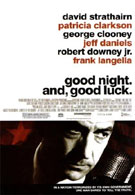The McCarthy era, an infamous blemish on American history, comes back to haunt us in George Clooney’s feature Good Night, and Good Luck. Senator McCarthy and the House Un-American Activities Community in the early 1950’s sent the country on a wild goose chase for anyone remotely associated with Communism. If you ever attended a Communist meeting, rubbed shoulders with someone who believed in the system, or liked to wear the color red, you were likely to find yourself calling a prison cell home.
Good Night, and Good Luck opens with widely respected CBS anchor Edward R. Murrow being honored in a ceremony for changing the face of Journalism. At a time when everyone was terrified of their own government, he took a stand and flipped the Feds off. During a 1954 broadcast, Murrow did a character assassination piece on America’s ultimate nosey neighbor Senator McCarthy, using footage of his own words and pictures. Producer Fred Friendly (George Clooney) joined this labor-of-love, with passionate colleagues including married couple Joe (Robert Downey Jr.) and Shirley Wershba (Patricia Clarkson) in tow. Studio executive William S. Paley (Frank Langella) wanted the piece pulled in order to protect the network's reputation, but the team wasn’t scared of him or the other bigwigs. If they lost their jobs or wound up on trial themselves, so be it. They had a message to deliver.
Their moral message resonates throughout the picture, but it lacks any kind of sparkle. When even a great man like Murrow remains a stranger to the audience, it is hard to truly connect with him or his fellows. We learn virtually nothing about him, except for a burning desire to run his piece at any cost. The same goes for Good Night’s supporting characters. Joe and Shirley exhibit no real personality traits, except for the fact that we know they’re married. Fred Friendly likes to wear big black glasses. Jeff Daniels is listed in the press notes, but I sure don’t remember seeing him.
The film is shot in black and white to give it an authentic, old-fashioned feel for the time. Foregoing color was a daring move for director George Clooney, and it could have been a mistake. But it works because it makes the film look classy, sophisticated, and separates it from the droves of other independent movies not taking any chances. Yet the movie’s lack of color is a reflection of the general drabness of the film itself, from its story to its characters. The only thing that gives it any personality is the way it was shot.
Good Night, and Good Luck plays more like a history channel exclusive than a well fleshed-out movie. It relies entirely on facts, and is completely devoid of emotion, heart, and strong characterization. The film comes across like a textbook brought to life, and while that will no doubt interest people fascinated by this specific period of time, it isolates the rest of us. Knowing who these people were and caring about them would have helped raise audience interest in their landmark accomplishments in the TV studio. Such an important event could have been a phenomenal viewing experience, but instead it plays like a slow-moving cure for insomnia. Good night, good luck, and good riddance.
Your Daily Blend of Entertainment News

